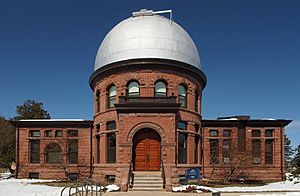Goodsell Observatory facts for kids
Quick facts for kids Goodsell Observatory |
|||||||||||||||||||||||||
|---|---|---|---|---|---|---|---|---|---|---|---|---|---|---|---|---|---|---|---|---|---|---|---|---|---|

Goodsell Observatory from the south
|
|||||||||||||||||||||||||
| Organization | Carleton College | ||||||||||||||||||||||||
| Location | Northfield, Minnesota, US | ||||||||||||||||||||||||
|
Coordinates
|
44°27′43″N 93°09′09″W / 44.46194°N 93.15250°W
|
||||||||||||||||||||||||
| Altitude | 290 meters | ||||||||||||||||||||||||
| Weather | See the Clear Sky Clock | ||||||||||||||||||||||||
| Established | 1887 | ||||||||||||||||||||||||
| Website [1] |
|||||||||||||||||||||||||
|
|||||||||||||||||||||||||
The Goodsell Observatory is a special building at Carleton College in Northfield, Minnesota, United States. It was built in 1887. At that time, it was the biggest observatory in Minnesota.
This observatory, and an older, smaller one built in 1878, were very important for keeping time. They helped Carleton College become well-known in the late 1800s and early 1900s.
Goodsell Observatory was added to the National Register of Historic Places in 1975. This means it's a very important historical site. It was recognized for its amazing architecture, its role in communication, education, and science. It's one of the few old observatories from the 1800s that is still mostly the same. It also has many old science tools.
The observatory was also important for its timekeeping service. Its founder, William W. Payne, also started a science magazine called Popular Astronomy. The building has beautiful Romanesque Revival architecture. Today, the telescope is still used for astronomy classes. The building also has offices and classrooms for other college subjects.
Contents
How Goodsell Observatory Began
William W. Payne was one of the first teachers at Carleton College. He taught math and science. He started a class about astronomy in his first year. This class became very popular.
Because of this, the college decided to build a small observatory on campus. It was the fifth building ever built at Carleton. Even though it was small, it had excellent tools. These included an 8¼-inch telescope made by Alvan Clark & Sons.
Sending Time Signals
Soon after the small observatory opened in 1878, a telegraph line was set up. It connected the college to central Northfield. The observatory then started sending a time signal every day. This signal was sent at three minutes before noon.
The time signal was based on careful measurements of the stars. Cities all over Minnesota used this signal. Banks, jewelers, and many railroad companies in the Northwest also used it. This included big companies like the Northern Pacific Railway and the Great Northern Railway (U.S.).
In 1881, the U.S. Army Signal Corps placed a station at the observatory. They used it to send weather information to Washington, D.C.. The observatory also served as the main office for a state weather service from 1883 to 1886.
Building the New Observatory
In 1886, the college bought a new, very precise tool called a meridian circle. James J. Hill gave $5,000 for it. His railroad companies benefited a lot from Carleton's accurate time service.
The new meridian circle was too big for the old building. So, Carleton decided to build a bigger, new observatory. Harvey Ellis designed the second observatory. He worked for an architectural firm in Saint Paul, Minnesota. The new building was finished in 1887. It was named after Charles M. Goodsell, one of the college's founders.
Goodsell's Impact on Railroads
By 1888, the time signals from Goodsell Observatory were used on more than 12,000 miles (19,000 km) of railroad tracks. Railroad companies in the Northwest thought Carleton's signal was even more accurate than the one from the United States Naval Observatory in Washington, D.C.
Accurate time was extremely important for railroads. It helped prevent train crashes and kept trains running on schedule.
In 1891, Goodsell Observatory got a new 16.2-inch telescope. It was made by the famous John Brashear from Pennsylvania. The special mount for the telescope was built by Warner & Swasey Company in Ohio. At that time, it was the twelfth-largest telescope of its kind in the world. It was the sixth-largest in the United States.
The old observatory building was later turned into a library. Then, it was torn down in 1905 to make space for a new building. In 1910, the observatory got a sidereal clock, which measures time based on the stars. In 1922, a Carleton professor named Edward Fath built one of the first photoelectric photometers in Goodsell. This tool measures light.
The time service continued until 1931. Astronomy remained a very important subject at Carleton College for many years.
Goodsell Observatory was so well-designed that it became a model for the Chamberlin Observatory at the University of Denver.
The collection of meteorites you can see at Goodsell was given to the college in 1942. A scientist named Harvey H. Nininger gave them as payment for his daughter's college tuition.
Images for kids



